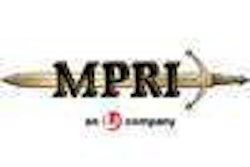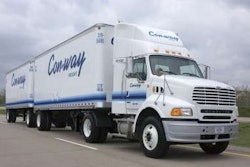Onboard platforms offer new functionality for fleets that want to have it all
Text-to-speech technology was enough reason for John Pope to convert nearly 400 trucks to a new onboard computing platform. The technology enables drivers to hear incoming messages while keeping their hands on the wheel and their eyes on the road.
Since converting to Qualcomm’s OmniVision in January 2007, Pope – chairman of Claremont, N.C.-based Cargo Transporters – has decided to build upon this platform to improve driver safety. “Within our company, what drives investment are safety items,” Pope says. “We are much more apt to invest for safety applications than for any others.”
Soon after installing the hardware, fleet managers began receiving real-time alerts for critical safety events such as rapid deceleration, speeding and activation of vehicles’ roll-stability control systems. Last November, Cargo Transporters implemented electronic logs; since then, not a single driver has been placed out-of-service because of a log violation, Pope says. In March, the company integrated in-cab navigation from Maptuit’s NaviGo with its AS400 dispatch software system; drivers now can hear and see turn-by-turn directions from pickup to delivery without the need to enter addresses into the computer.
In the near future, Cargo Transporters plans to add more tools to monitor vehicle and driver performance. To help prevent future breakdowns, critical engine and vehicle fault codes such as low oil pressure or high temperature problems will be sent to fleet managers in real time.
Nothing evolves as fast as technology, which is why investing in new onboard computers might seem risky in the sense that the technology will become outdated as soon as you write the check. But as Cargo Transporters and many other fleets are realizing, today’s mobile computing and communications technology is really a platform that can be expanded continuously and allow for new additions and improvements for years to come.
Driver communications
The latest computing platforms feature high-resolution color touchscreen displays, Windows operating systems and processing power that rivals any office PC. Included in several of the latest platforms is multimode communications via satellite, cellular and 802.11 (Wi-Fi) wireless networks.
High-speed cellular and Wi-Fi networks allow fleets to transmit and store large packets of data, including video and audio files, between the office and vehicle. U.S. Xpress Enterprises is using the multimode capabilities of its onboard computing platform, the DriverTech DT4000 TruckPC, to collect more information about its operations while pushing more content to drivers. Since implementing DriverTech in 2006, U.S. Xpress Enterprises also has developed its own software applications for the new platform while leveraging several commercial offerings.
The Chattanooga, Tenn.-based company – which operates a combined fleet of 10,000 vehicles, with 5,400 belonging to its largest division, U.S. Xpress – has downloaded training videos from various equipment suppliers for its engines and transmissions to its onboard platform. Within 30 to 45 minutes of watching these training videos, a driver in a new truck can learn how to operate unfamiliar equipment, says Max Fuller, chief executive officer of U.S. Xpress Enterprises.
The company also has produced several training videos internally by filming Ron Viso, vice president of safety, teaching drivers how to perform pre-trip inspections and prevent slip-and-fall accidents. In the near future, Fuller plans to produce regular video messages and audio clips from him and other company executives as a “fireside chat”-style of conversation.
One of the commercial products U.S. Xpress Enterprises uses is Pro-Tread’s driver safety training software from Instructional Technologies Inc. The software is loaded onto DriverTech’s TruckPC for drivers to use anytime they choose. When drivers complete a course, the onboard computer transmits information about the lesson – date, time, driver ID and completion information – to the Web-based Pro-Tread system for fleet managers to track and manage the results.
In addition to improving driver communications and distance training, U.S. Xpress Enterprises also is making headway in driver performance and route management. The company plans to roll out electronic logs to its entire fleet this year, and it also is developing driver performance reports to identify drivers that may be lacking certain skills. These drivers will receive extra training in the company’s driver simulators, Fuller says.
To provide drivers with better directions, the company uses CoPilot onboard navigation software from ALK Technologies. U.S. Xpress Enterprises also has developed an application that uses “geotunneling” to monitor the coordinates of the vehicle in relation to the route; managers receive an alert whenever a driver veers more than 5 miles off route. As a result of these improvements, out-of-route mileage has decreased by nearly 80 percent from two years ago, Fuller says.
“We are using a lot more proactive notification to get ahead of the problem instead of behind it,” he says.
An all-in-one safety solution
When fleet executives consider options for maximizing their return on investments in new technology, safety and risk management often takes priority; preventing just one accident could mean millions in savings.
During the last eight months, Schneider National has been testing in-cab solutions from multiple providers, says Don Osterberg, senior vice president of safety and driver training. The Green Bay, Wis.-based company plans to select a new computing platform shortly and will begin installation throughout its large fleet later this year.
Based on extensive tests of new applications available from onboard computing providers, Osterberg says the two that will have the most immediate, positive benefit are electronic logs and spoken street-level directions.
Electronic logs with real-time communications will provide operational and safety benefits, Osterberg says; by eliminating handwritten logs, drivers will have more productive time, and Schneider will be able to use its real-time visibility of drivers’ hours to make better dispatch decisions. And having street-level directions in a text-to-voice format will improve drivers’ situational awareness, he says. “When drivers are lost, they make bad decisions.”
Computer-based driver training modules are another application that ranks high on Schneider’s priority list. With training modules in the cab, the fleet could require a driver to complete a training module on speeding or another moving violation on the day that such an incident occurred, rather than waiting for the driver to return to a company facility.
In the near future, Schneider will integrate multiple safety systems – including active collision warning, collision avoidance and driver fatigue monitoring- to its new onboard computing platform. Osterberg anticipates this will spearhead changes in the company’s processes for dispatch and risk management. Each driver will have a detailed risk profile that is based on current performance data, and separate interventions can be assigned to each area of risk.
“One of the requirements is for the systems to be very adaptable to additional growth in driver performance monitoring,” he says. “We will have better visibility and be able to tailor interventions to remediate (risk) before we have a crash.”
Open for integration
Fleet executives have various reasons and priorities for maximizing their investment in the latest onboard computers. In addition to the initial reasons for the purchase, fleets benefit from the flexibility provided by today’s platforms to tailor the hardware and software to meet additional present and future needs.
Xata Corp. gives customers a choice of deploying either handheld computers or a fixed-mount display to run its Xatanet fleet management software. Over the past four years, the company has developed software for a Windows in-cab platform for applications that include fuel and cost management, compliance and data integration with third-party routing and dispatch software systems.
A customer’s hardware platform preference is driven by what applications they want, says Tom Flies, Xata’s senior vice president of product management. Fleets that want to use in-cab navigation likely would choose a fixed-mount display to have the required processing power and memory. Using a fixed-mount display also allows more connectivity options to other onboard devices and sensors, Flies says. If the customer needed to include barcode scanning for proof-of-delivery, they would choose an in-cab handheld device from Intermec or Motorola.
Because of the fast-paced changes in computing technology, some vendors have chosen to design platforms that leverage popular consumer hardware such as laptops, handhelds and smart phones.
Last fall, J.J. Keller released Keller Mobile as a cost-effective system for fleet and driver compliance. For about $500 and in less than 30 minutes per vehicle, fleets can install an onboard recorder that captures the data necessary to automate fuel-tax reporting, electronic logs, electronic vehicle inspections and driver performance reporting, says Amy Daley, product manager.
The recorder connects wirelessly to Keller Mobile software applications that run on any number of Windows Mobile hardware devices – a laptop, handheld or smart phone – using Bluetooth technology. Customers can buy their own wireless data plan and install any additional applications on the mobile device of their choice.
One of the advantages of this type of platform, Daley says, is that even if a fleet’s hardware or software technology needs change, they keep the onboard recorder while making the switch to new mobile devices.
Another strategy for keeping hardware costs competitive is to leverage high-speed wireless networks. By sending more data to a server for processing, fleets do not have to pay more for added memory and processing power onboard the vehicle.
“Our focus has been ‘always-on’ connectivity,” says Norman Thomas, vice president of consulting services for CarrierWeb. The company offers customers a fixed monthly charge for unlimited communications. Hardware costs are low compared to its competitors, Thomas says, because CarrierWeb has built a platform that sends data to servers in real time rather than using processing power and memory in the in-cab computer.
Removing all constraints
In addition to offering customers more flexibility and choices in hardware, technology providers also have moved toward using an XML-based Web services architecture that gives customers the ultimate decision in how to access and consume their data. This architecture makes it easier for fleets and technology vendors to integrate existing or new software applications to the platform.
PeopleNet offers several services generically called “application enablers” that give customers the ultimate choice in how they configure the company’s hardware and software applications to integrate with other information systems, says Randy Boyles, vice president of PeopleNet’s Tailored Solutions division.
PeopleNet’s G3 Services uses an application programming interface (API) that permits customers and third parties to access the software code of PeopleNet’s g3 onboard computing platform; similarly, G3 Services allows the g3 computer to access data from those applications. For PeopleNet’s latest in-cab PC platform called BLU, the company offers a similar service called BLULink, which gives customers the ability to develop and manage their own applications.
To facilitate real-time integration of data collected from the vehicle to any type of database or software application a fleet uses internally, the company offers PeopleNet Link, a server that resides directly on a company’s network.
Fleets looking to make new gains in productivity, safety and other areas critical to profitability are realizing that the truck cab must be an integral part of any fully networked computer system. By investing in today’s onboard computers, companies will be able to integrate tomorrow’s technology for years to come.
Graphical views
Business intelligence makes more information easier to manage
Aconsequence of being able to gather more information from a vehicle is that today’s computing platforms easily can collect more data than fleets can use effectively. That’s why technology providers continue to develop business intelligence tools, which offer more intuitive means for customers to utilize their data to help them make better business decisions.
“We have been doing business intelligence for a long time,” says Tom Flies, Xata Corp.’s senior vice president of product management. “The key thing we see is the ability to collect a lot of information onboard the vehicle and present it to users in a meaningful way.”
Nearly all technology providers now offer advanced business intelligence tools as part of their standard Web-based interface. With these tools, fleet managers and executives can create custom, graphical views of data for any number of key areas of vehicle and driver performance.
Qualcomm Enterprise Services has added business intelligence software into several new product releases. Last fall, the company released Fuel Manager, a Web-based software interface that customers can use to analyze fuel data in various ways – by driver, vehicle model or year, engine type, etc.
Last fall, PeopleNet redesigned its Web-based interface, PeopleNet Fleet Manager, to enable more creative, graphical data use via dashboards and scorecards with drill-down capabilities. The company continues to develop new business intelligence tools by using a third-party software system called Business Objects.
In some instances, vendors are developing business intelligence tools for fleets that wish to consolidate data from sources outside the vehicle and throughout their enterprise.
Qualcomm’s Predictive Performance Service (PPS) uses data aggregation, pattern recognition technology and specific knowledge to help carriers identify potential limitations impacting their business and safety performance. PPS takes all data collected by Qualcomm as well as data from other non-Qualcomm applications that fleets run in their organization.
“We make that into one large database and run it through an algorithm to get different information,” says Monica Wyly, senior product marketing manager for QES. Qualcomm has developed different modules to analyze a fleet’s safety, driver performance, retention and hiring practices.
Last fall, Cadec – which offers the Mobius and PowerVue onboard computing systems – partnered with Blue Sky Technologies to introduce Mobius Insight. The business intelligence software is offered as an add-on subscription to Cadec’s Mobius TTS fleet management software platform. The new software gives preconfigured business dashboards for transportation executives on safety, customer service, compliance, maintenance and costs.
The ultimate objective for Cadec is to provide customers with a business intelligence platform to measure key indicators, monitor process improvements and maintain performance across the extended supply chain. Customers soon will be able to use Blue Sky “adapters” to integrate information from Mobius Insight with various other IT systems a carrier uses, such as a warehouse management or accounting system, says Frank Moreno, vice president of marketing for Cadec.
“There is a huge trend among our customers to go beyond fleet management,” Moreno says.












